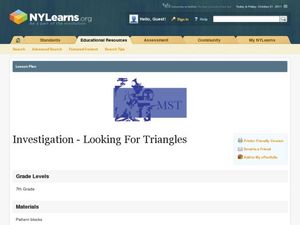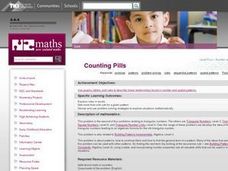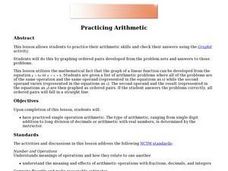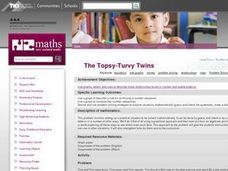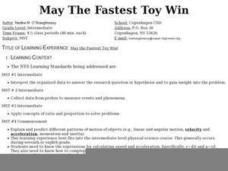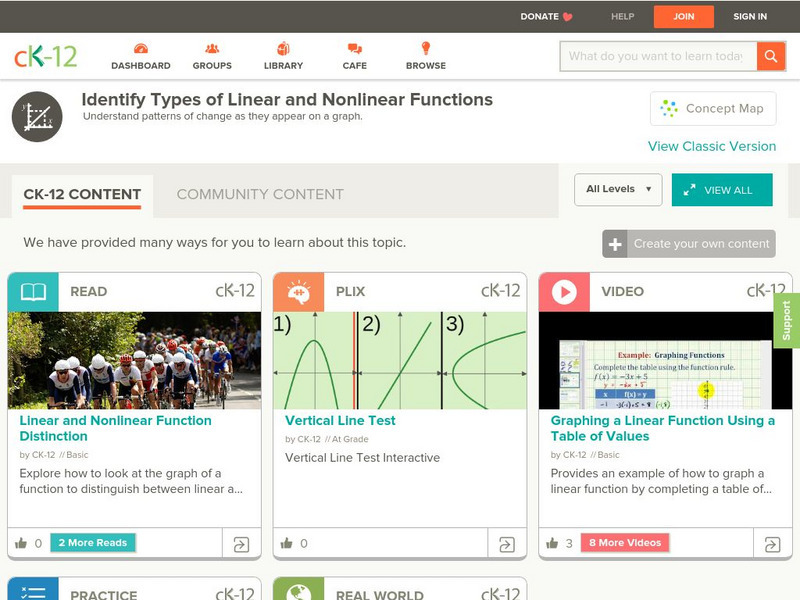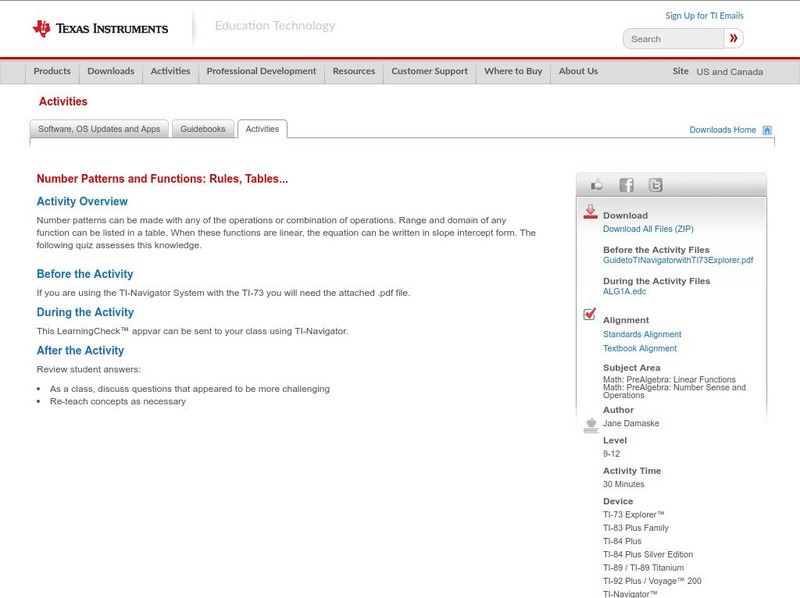Curated OER
Modeling With Circular Functions
Students explore circular functions. They identify the amplitude, period, phase shift and vertical shift of circular functions. Students analyze phenomena described by sine waves and they find mathematical models for transforming images...
Curated OER
Looking For Triangles
Students solve problems with triangles. In this geometry lesson, students analyze shapes to find different triangles. They name the shapes created by putting triangles together.
Curated OER
Counting Pills
Students are introduced to the problem. They brainstorm ideas for approaching the problem and keeping track of what has been done. Students work on the problem in pairs to discover what strategies might help to find the answer.
Curated OER
Impossible Graphs
Students distinguish between possible and impossible graphs of functions, and to learn why some graphs are impossible. They have practiced plotting functions on the Cartesian coordinate plane
Curated OER
Poppy Meets Pythagoras
Eighth graders find connections between numbers in a table; use Pythagoras' theorem in a general algebraic form; and measure accurately from a scale drawing to find a method that might enable the helicopter to land inside a rectangular...
Curated OER
Let's Go to Nagano!
Middle schoolers, individually and in groups, utilize Internet sites to access maps, scales, and information to assist them in calculating distances. They research modes of travel from their homes to Nagano, Japan, and write a travel...
Curated OER
The Chinese Zodiac
Students create their own personalized Zodiac page on a word processing
document after researching and discussing the origins of Zodiak signs. This lesson does include resource links and may be controversial.
Curated OER
Practicing Arithmetic
High schoolers practice single operation arithmetic ranging from single digit addition to long division of decimals or real numbers using Graphit. They use data sets and rules to graph ordered pairs.
Curated OER
What Configurations Work to Light a Bulb?
Students explore simple electrical circuits. Students experiment, using different configurations, to determine what is necessary to compeete a circuit. Students observe similarities between arrangements that work and differences in...
Curated OER
The Topsy-Turvy Twins
Fourth graders read the problem and brainstorm for ways to solve the problem - list these on the board for the students to refer to as they solve the problem. They work in pairs and focus on the strategy selected.
Curated OER
Hands On Math Lessons with Technology
Students explore a variety of math concepts. In this integrating technology lesson, students visit online webtools such as Max's Math Adventure, I Know That Math, Hands on Banking, and more. A description of each website is provided.
Curated OER
Confusing Colors!
Fourth graders collect data, graph their data, and then make predictions based upon their findings. They's interest is maintained by the interesting way the data is collected. The data collection experiment is from the psychology work of...
Curated OER
May The Fastest Toy Win
Students determine which wind-up toy is the fastest. However, they can NOT race the toys. They must find another way. On the first day of the activity, students work in pairs or small groups to develop and write a plan.
Curated OER
Flow Rates of Faucets and Rivers
Students work together to discover the flow rates of faucets and rivers. They relate their results to engineering and applied science concepts. They make predictions on the flow rate of a nearby river in their local community.
Curated OER
Review for the Algebra One SOLs
Students review the standards for Algebra I. Using the text, they discover two problems that match each standard and solve them showing all steps on paper. They create a PowerPoint slide for each problem and go through the correct...
Curated OER
You Can Count on Squares!
Fourth graders engage in and explore to develop mathematical, specifically algebraic, ideas. Although the tasks are built around measurement, they are algebraic to the extent that they require 'formulae' to be derived form the geometric...
Curated OER
QwikQure Algebra
Fourth graders are introduced to the problem using a bottle of medicine. They estimate the volume of the medicine and predict the instructions on the bottle. They then think about how they might solve the problem before asking them to...
Curated OER
The Farmer's Sheep II
Fourth graders listen to the story of a farmer who only likes to be able to see nine sheet from his window. His wife has brought him another sheep - what now? They work together in pairs to solve the problem and share solutions.
Curated OER
Free Cell
Fourth graders use algebra to begin solving a problem. The problem has a real world application to engage learners. The main skill is converting fractions and decimals. Also finding the right number sentence for the word problem is...
CK-12 Foundation
Ck 12: Algebra: Linear and Non Linear Patterns of Change
[Free Registration/Login may be required to access all resource tools.] Model and solve real-world problems involving patterns of change
Other
Brooklyn Children's Museum: Pattern Wizardry!
Interactive exhibition answers all kinds of questions about patterns, symmetry, and tessellations. With games that reinforce concepts and loads of great illustrations. [Requires Shockwave.]
Texas Instruments
Texas Instruments: Number Patterns and Functions: Rules, Tables
Number patterns can be made with any of the operations or combination of operations. Range and domain of any function can be listed in a table. When these functions are linear, the equation can be written in slope intercept form.
Shodor Education Foundation
Shodor Interactivate: Positive Linear Function Machine
The interactive activity has students explore positive linear functions by looking for patterns in the outputs to determine the function. The activity and teacher resources are included.
CK-12 Foundation
Ck 12: Algebra: Linear Interpolation and Extrapolation
[Free Registration/Login may be required to access all resource tools.] Learn how to use linear interpolation and extrapolation to make predictions.
Other popular searches
- Linear Patterns Word Problem
- Linear Patterns Graphing
- Linear Patterns and Graphs
- Linear Patterns and Plotting
- Algebra Linear Patterns
- Describing Linear Patterns
- Linear Patterns in Data
- Recognize Linear Patterns
- Extending Linear Patterns
- Growing Linear Patterns
- Simple Linear Patterns
- Non Linear Patterns



